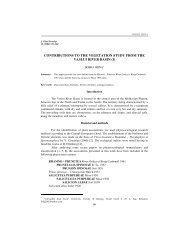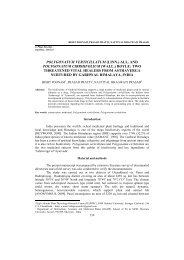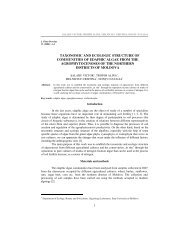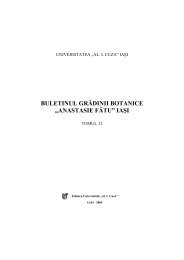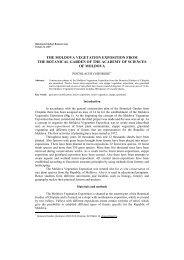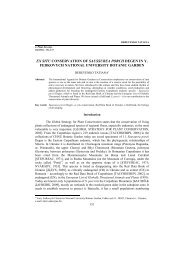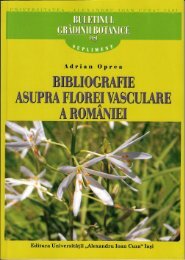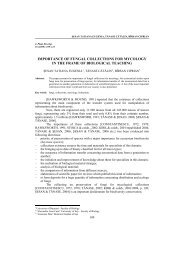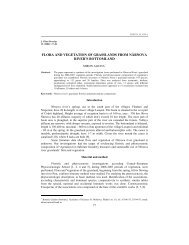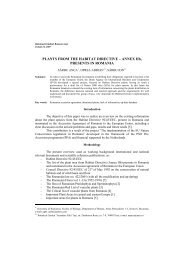the conservation of species bellevalia sarmatica - Journal of Plant ...
the conservation of species bellevalia sarmatica - Journal of Plant ...
the conservation of species bellevalia sarmatica - Journal of Plant ...
Create successful ePaper yourself
Turn your PDF publications into a flip-book with our unique Google optimized e-Paper software.
SEDCENCO MARIA, CIORCHINĂ NINA, CLAPA DOINA, FIRA ALEXANDRU<br />
(BAP) and 0.25 mg/l - α-naphtylacetic acid (NAA) and 30 g/l sucrose (B-1). After 6 weeks<br />
<strong>of</strong> culture, 10-12 bulbs/explant were obtained, with a diameter <strong>of</strong> about 3.0 mm (Fig. 1, a).<br />
On <strong>the</strong> B-2 medium, with a lower BAP concentration (0.5 mg/l) feweer bulbs fewer bulbs<br />
were formed (7-9 bulbs/explant). Regeneration also took place on <strong>the</strong> medium with Kinetin<br />
(B-3), but in a lower percentage (4-6 bulbils/explant). The first de novo regenerated bulbils<br />
on this medium were noticed after 8 weeks in culture. This fact demonstrates that <strong>the</strong><br />
presence <strong>of</strong> BAP leads to a better growth <strong>of</strong> isolated tissues and better organogenesis as<br />
compared to <strong>the</strong> variants with Kinetin [VOINOV & al. 2009]<br />
The bulbs obtained were transferred onto culture media with higher concentrations<br />
<strong>of</strong> plant hormones and sucrose. On <strong>the</strong> media with increased concentration <strong>of</strong> sucrose a<br />
more rapid growth <strong>of</strong> bulbils was observed and <strong>the</strong>re <strong>the</strong> bulbs had <strong>the</strong> largest diameters, <strong>of</strong><br />
14-17 mm. After two weeks <strong>of</strong> culture on B-6, B-9 media <strong>the</strong> bulbs formed roots and<br />
leaves. Between <strong>the</strong> two variants <strong>of</strong> media, B-6 and B-9 <strong>the</strong>re were no significant<br />
differences regarding growth and organogenesis, so that for this stage <strong>the</strong> B-6 medium with<br />
60 g/l sucrose can be recommended (Fig. 1, b).<br />
The bulbs that were regenerated in vitro were acclimated ex vitro and successfully<br />
transferred to ex vitro conditions. Acclimatization was carried aut in conditions <strong>of</strong><br />
controlled climate regarding humidity and temperature, in peat and perlite mixture, for 14<br />
days. The survival rate was <strong>of</strong> 100% and plant growth and development continued.<br />
The results obtained in this <strong>species</strong> are promising, so <strong>the</strong> method <strong>of</strong> vitrocultures<br />
will be extended for o<strong>the</strong>r important and endangered taxons from <strong>the</strong> spontaneous flora,<br />
which is constantly diminishing and necessitates protection.<br />
Conclusions<br />
On <strong>the</strong> basis <strong>of</strong> our research we can conclude that:<br />
For <strong>the</strong> sterilization <strong>of</strong> plant material (bulbs) for <strong>the</strong> initiation <strong>of</strong> in vitro culture <strong>of</strong><br />
<strong>species</strong> Bellevalia <strong>sarmatica</strong> (Georgi) Woronow it is recommended to use disinfection with<br />
KMnO4 (0.05%) + Tween-20 for 10 minutes and diacid (0.01%) solution for 6-7 minutes.<br />
On <strong>the</strong> basal MS medium supplemented with BАP and NAA at <strong>the</strong> concentrations<br />
<strong>of</strong> 1.0 mg/l and respectively 0.25 mg/l <strong>the</strong> best results were obtained regarding <strong>the</strong><br />
efficiency <strong>of</strong> microcloning and morphogenic potential.<br />
The optimal medium for rhyzogenesis and rapid growth was MS basal medium<br />
supplemented with BАP (1.0 mg/l), NAA (1.0 mg/l) and sucrose at <strong>the</strong> concentration <strong>of</strong> 60 g/l.<br />
For <strong>the</strong> acclimation <strong>of</strong> bulbs <strong>the</strong> optimal conditions were found and <strong>the</strong> time for<br />
flower-bearing bulb formation was reduced with 1-2 years.<br />
The protocol for micropropagation and medium-term maintenance in in vitro culture<br />
can be successfully used for <strong>the</strong> <strong>conservation</strong> <strong>of</strong> <strong>the</strong> endangered <strong>species</strong> Bellevalia <strong>sarmatica</strong><br />
(Georgi) Woronow. Applying this method ensures <strong>the</strong> possibility <strong>of</strong> obtaining homogenous<br />
planting material in large amounts in a short period <strong>of</strong> time and in limited space.<br />
Acknowledgements<br />
This work was supported by ANCS Romania, project number 425/2010, Bilateral<br />
Cooperations.<br />
13



